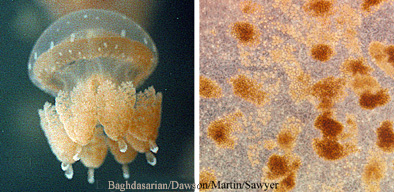Mutualism
Mutualisms are symbioses from which all organisms benefit.
A common example of commensalism involves photosynthetic dinoflagellates, called zooxanthellae, and tropical jellyfish belonging to at least two orders, the Coronatae and Rhizostomeae. The microscopic zooxanthellae live within the tissues of the much larger jellyfish. The zooxanthellae convert sunlight and inorganic compounds (e.g. water, carbon, nitrogen) into energy rich organic molecules (carbohydrates) that they use to live and grow. However, some of these organic molecules also become available to the host jellyfish, so it benefits also. In turn, the jellyfish's metabolism produces inorganic molecules (e.g. ammonium) as waste products, some of which become available to the zooxanthellae. the zooxanthellae use the inorganic molecules to make more organics.

The golden jellyfish, Mastigias papua (left), is given its colour by
the photosynthetic pigments in symbiotic zooxanthellae (right).
Prepared by Mike Dawson, Laura Martin.